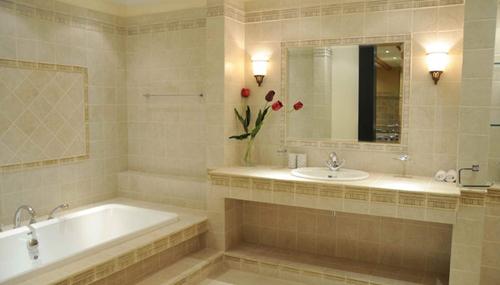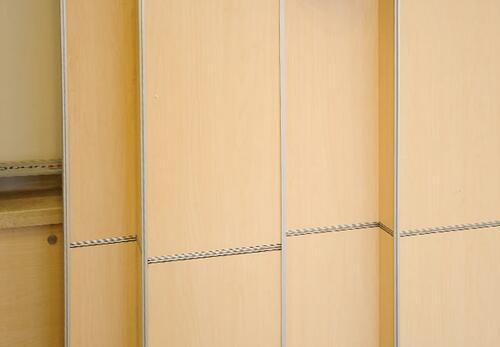There are many kinds of bathroom wall decoration materials, such as wall tiles, waterproof paints, decorative panels, etc. Different materials can also create different effects. Among the many bathroom wall decoration materials, tiles are generally the first choice for owners, especially light-colored tiles, which are even more popular. Because tiles are waterproof, non-slip, easy to clean and other characteristics, it has always been the first choice for the owner's decoration. Today we come to in-depth understanding of the bathroom wall decoration materials. The design of the bathroom is basically based on convenience, safety, easy cleaning and appearance. Due to the heavy moisture in the bathroom, the interior decoration materials must be made of waterproof material. Bathroom walls and floors occupy the largest area, so materials that are both waterproof and resistant to corrosion and mildew should be selected to ensure indoor hygiene. Natural stone such as marble has a special texture, and many people will choose. Bathroom wall decoration materials 1, waterproof wallpaper I heard that wallpaper can remove formaldehyde, and then see the waterproof wallpaper is much lighter. The development of science and technology is so fast that every decoration is a product knowledge spread. The waterproof wallpaper as a special wallpaper, paving in wet and dry partitions of the bathroom, to avoid the bathroom gives the icy feeling, and then with mosaics, tiles and other wall decorative materials, small wallpaper can also bloom different glory. 2, waterproof board A board that is specially designed for showers. This type of floor is generally treated with special techniques such as waterproofing and antisepsis. It not only retains the natural good properties of the wood, but also is not afraid of showers with high humidity. Among them, the technology of the sauna board is the most mature, the installation is simple, and the cleaning is convenient. The price ranges from several tens of yuan. 3, decorative panel The interior wall materials include various types of protective wall panels, wooden wall skirts, or cover panels. The materials used are plywood, plastic sheets, aluminum alloy sheets, stainless steel sheets, and plated plastic sheets, galvanized sheets, and enamel sheets. Plywood is the main type of interior wall veneer, according to the number of layers can be divided into plywood, five-plywood, etc., according to its species can be divided into ash, eucalyptus, Phoebe, teak and so on. Interior wall veneers are now becoming more natural. 4, diatom mud Diatom mud wall material is an efficient matting and light-absorbing material, which can regulate air humidity, adsorb formaldehyde, and purify air to improve the indoor small environment. Currently, it is used more and more widely. Designer Li Zhichao told the reporter that the diatom mud is more environmentally friendly, has no taste, and has a smell of diatomaceous earth at most. Since the diatom mud wall material is a natural mineral raw material, the space coated with diatom mud gives a very soft feeling. Comfortable. Compared with wallpapers, diatom mud wall materials are also more economical, and ordinary working people can afford it. 5, waterproof wall paint Waterproof wall paint because of the addition of waterproof breathable material in the composition, so after the brushing can form a film, so that water molecules can not penetrate them, so as to better protect the wall, so it is particularly suitable for use in the bathroom. Many people now have a mosaic on the wall and a combination of latex paint that is visually pleasing. Bathroom wall decoration steps 1, the selection and soaking of ceramic tiles Before the tiles are tiled, regardless of whether they are white or other colored tiles, the specifications and colors must be selected. In addition, p is the same quality grade tile produced by the same manufacturer. There are some differences in quality, color, and specifications. Use a slightly better tile for the prominent wall, and apply the slightly inferior tile to the dark corner. Prior to affixing, the selected tiles should be soaked in clear water and allowed to dry before use. 2. Treatment of the wall The wall treatment mentioned here is mainly for the new residential bathroom tiles. Since 1.2m or less of the sanitary wall is a cement wall, and 1.2m or more is a paper gray wall, the wall must be treated before the tiles are tiled. For the treatment of the bathroom wall, one layer of cement mortar mixed with 3 points of sand can be applied. Because the cement wall below 1.2m protrudes from the paper gray wall surface above 1.2m, it should be smeared at 1.2m to a small thickness of 1.2m in order to be thinner, so that the entire wall is vertical and flat. Wait 2 days before starting to tile. 3, wet wall Clean the surface of the treated wall, remove excess pulp and burrs from the wall and inside corners, etc., then sprinkle with water and dampen it, or brush the wet wall with a row of wool pens. 4, preparation of adhesive mortar The cement mortar was made with the ratio of cement and 107 glue technique 102l. Then, it was scraped on the back of the tile and was ready for pasting. 5, tile In the public bathroom, along the wall and the ground, the tiles coated with adhesive mortar were affixed to the wall, and the brick was tapped with a wooden spatula to fill the mortar. The wooden tile was used to flatten the tiles. . Holding mortar is not enough, you must remove the tiles, add mortar, re-apply. Do not put mortar on the edge of the tile, otherwise it will produce a middle drum. It must be noted that the first layer of tiles is well applied and only horizontally flat with a wooden ruler. Splice tiles, mostly from the positive electricity, so that it can not be used in the whole corner of the block. If there is a hole in the wall, use a tile to face the hole in the hole. Use a pen to scratch the hole on the tile. Then place the tile on a flat hard object and use the alloy steel. Cut the knife and use a vise to clamp off the unwanted tiles. When the tile is attached to the most buzz layer, it needs to be a line, each tile seam is horizontal and vertical, and the unevenness should be leveled at any time. Most of the layers of tiled moss do not have a bead and can be finished with a round-edged tile. 6, rub the brick surface After the scene tiles are plastered, before the final setting of the binding mortar, the ash emerging from the joints of the tiles shall be wiped clean with waste paper, sawdust, cotton yarn, or sponge to prevent the mortar from hard to rub. 7, caulking In order to be neat and beautiful, the seam between the tile and the tile needs to be embedded with grout. White tiles, generally with white cement caulking color tiles, generally used in the color of cement slurry caulking. The preparation of colored cement slurry can be formulated by adding inorganic pigments such as oxidized iron oxide, yellow iron or copper yellow in the white cement slurry. Editor's summary: About the bathroom wall decoration materials introduced here, I hope to be helpful to everyone. If you want to know more about yourself, you can follow the information on this site. Decorative materials, bathroom wall decoration materials
Litsea cubeba Essential Oil is used in countless products that commonly has been used in repelling insects. Also many people enjoy its aroma therapeutic uses and place the Litsea cubeba oil in a diffuser to lighten and energize the air.
Litsea Cubeba Essential Oil,Natural Litsea Cubeba Essential Oil,Pure Litsea Cubeba Essential Oil,Organic Litsea Cubeba Essential Oil Xinhui Gangzhou Flavors&Fragrance Co.,Ltd , https://www.xhgzff.com

